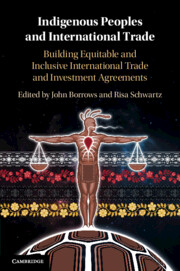 Indigenous Peoples and International Trade
Indigenous Peoples and International Trade from Part I - Indigenous Peoples and International Trade and Investment
Published online by Cambridge University Press: 11 June 2020
In Chapter 2, Angelique EagleWoman (Wambdi A. Was’teWinyan) explores some historical trade relationships and the vast networks connecting Indigenous commerce in the Americas. She sets forth the values and worldviews that traditionally undergirded the commercial framework as well as providing an overview of the inter-nation trade in goods and services that has developed over hundreds of years. The chapter closes with insight into the potential for revitalizing and reconnecting traditional trade alliances to rebuild Indigenous economies.
To save this book to your Kindle, first ensure [email protected] is added to your Approved Personal Document E-mail List under your Personal Document Settings on the Manage Your Content and Devices page of your Amazon account. Then enter the ‘name’ part of your Kindle email address below. Find out more about saving to your Kindle.
Note you can select to save to either the @free.kindle.com or @kindle.com variations. ‘@free.kindle.com’ emails are free but can only be saved to your device when it is connected to wi-fi. ‘@kindle.com’ emails can be delivered even when you are not connected to wi-fi, but note that service fees apply.
Find out more about the Kindle Personal Document Service.
To save content items to your account, please confirm that you agree to abide by our usage policies. If this is the first time you use this feature, you will be asked to authorise Cambridge Core to connect with your account. Find out more about saving content to Dropbox.
To save content items to your account, please confirm that you agree to abide by our usage policies. If this is the first time you use this feature, you will be asked to authorise Cambridge Core to connect with your account. Find out more about saving content to Google Drive.